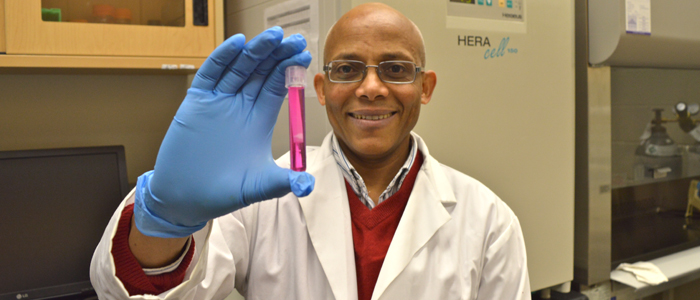Media
Contact
Communications Specialist
Faculty of Engineering
Spencer Engineering Building
Room 2072
Western University
Tel: 519-661-2111 ext. 87015
Email: engineeringcomms@uwo.ca
Engineered arteries to mend broken hearts

Western Engineering News | March 31, 2015
By Jason Teakle
Human cells growing into functional tissues in a lab may sound like a scene from a sci-fi movie, but research happening at Western Engineering has allowed for such a breakthrough, which is anticipated to benefit heart disease patients and provide more reliable testing of new medications during pharmaceutical trials.
Kibret Mequanint, a professor in the Department of Chemical and Biochemical Engineering, is growing engineered blood vessels using human cells for use in heart bypass surgery – and to improve clinical drug testing – before emerging pharmaceuticals hit the market and are prescribed to human patients. The research is funded by the Heart and Stroke Foundation of Canada and NSERC and includes a team of graduate students and postdoctoral fellows.
When multiple blockages affect blood flow to the heart, doctors are left with little choice but to conduct bypass surgery.
“In the event of a heart attack, the heart will eventually die because it is being starved of oxygen,” said Mequanint. “It is not the heart that is the problem per se – it’s the blood vessels that are unable to supply oxygen to the heart. I’m trying to fabricate the blood vessel that is supplying oxygen and nutrients to the heart.”
During bypass surgery, veins are often harvested from patients’ own legs to build a literal ‘bypass’ around the blockages and connect the aorta to the area of the heart being starved of nutrients.
“This vein has an average lifetime of about 10 years after surgery,” said Mequanint. “The second option is a synthetic material like a plastic tube, but it initiates blood clotting and rejection by the body, because it is a foreign material – and to mitigate these issues, you have to take a cocktail of drugs, which often results in undesirable side effects.”
In response to these issues faced by the medical community, Mequanint’s research team is growing blood vessels in the lab to address the challenges physicians face when using harvested veins and synthetic materials.
“If we design an artery, the problem with harvested veins is solved because an artery is stronger, but, if we’re trying to address the rejection issue – then the patients’ own cells must be used,” explained Mequanint. “If patients are made aware that they will require an engineered artery, they could have their cells harvested and we can grow them in the lab in about four to 12 weeks.”
The research project seeks to ensure that engineered arteries are grown in a way that copies the natural tissue properties in the body. Mequanint’s lab is specifically looking at a protein called elastin – which causes blood vessels to have much-needed elasticity – but is the most difficult protein to produce in engineered blood vessels.
“We die with the amount of elastin we have shortly after birth, and so we’re taking cells from an adult population who have long forgotten how to make elastin,” said Mequanint. “Now, we are instructing cells to assemble elastin the way they do in the body.”
The technology is inching closer to being a reality, but the regulatory process could take years. However, engineered arteries have another key application.
“The Holy Grail is to save lives, but now we can use these tissues to do drug discovery,” said Mequanint. “Candidate drugs can be studied on human tissues in a lab setting, without involving actual people, which accelerates drug discovery. It is not a question of if, but when, engineered arteries will be used in hospitals and the pharmaceutical industry.”

